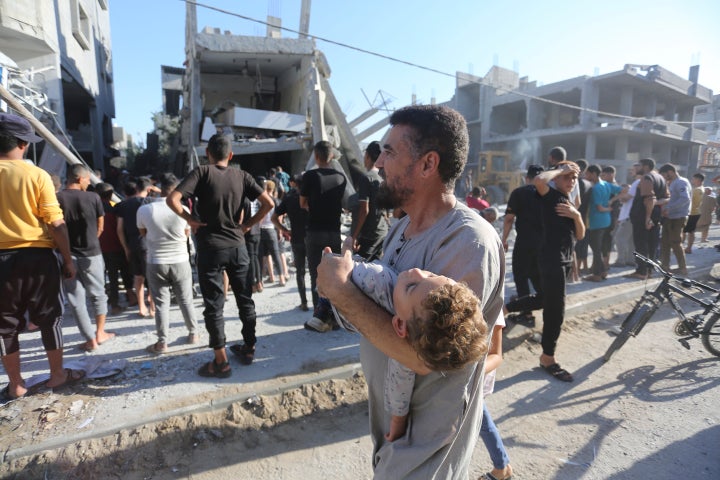President Joe Biden on Wednesday cast doubt on the casualty figures reported from Gaza as Israel continues its U.S.-backed military operation there, telling reporters: “I have no notion that the Palestinians are telling the truth about how many people are killed.” But within Biden’s own administration, officials have consistently cited the death toll and other data provided by authorities inside Gaza, according to a HuffPost review of internal State Department documents.
HuffPost reviewed nearly 20 State Department “situation reports,” with the earliest dating from Oct. 8, the day after the Palestinian militant group Hamas launched a devastating attack inside Israel that killed 1,400 people and sparked the current fighting. Most were prepared by the U.S. Embassy in Jerusalem and then circulated to a broad group of department officials working on issues related to Israel-Palestine. Situation reports such as these represent U.S. assessments from the ground that are intended to inform policy discussions and decision-making in Washington.
In at least 12 instances, U.S. embassy officials attributed the number of Palestinian casualties to the Hamas-linked Health Ministry in Gaza — including in the report provided to State Department colleagues on Oct. 25, hours before Biden’s remarks.
In two reports written by State’s Operations Center and circulated within the department on Oct. 24 and 25, administration officials reported casualties in Gaza by citing two outside sources who quoted the Gaza ministry in their reports: Al Jazeera and the nonprofit Save the Children. And in one instance in which a situation report questioned the accuracy of figures from the Gaza ministry, on Oct. 21, the American official drafting the note wrote of the number of Gazans killed or injured the previous day: “The numbers are likely much higher, according to the UN and NGOs reporting on the situation.”

That cable and one other are the only examples in which the reports include caveats about the ministry’s data, saying authorities inside Gaza have “effectively crumbled, reducing the credibility of [de facto authority] Ministry of Health-provided data.” Cables issued subsequently do not include that caveat and continue citing the ministry figures the same way they cite figures from Israel’s Ministry of Health.
The credibility of the ministry’s data is significant because there are few other sources of information about the situation in the blockaded region, and because some defenders of Israel’s actions in Gaza claim the ministry overstates the humanitarian toll of Israeli attacks for political reasons.
Most organizations and analysts tracking Gaza do treat the ministry as a reliable source, however, including the United Nations. The State Department has also publicly cited the ministry’s figures, for example in a report published earlier this year on the human rights situation in Israel-Palestine.
It’s unclear whether Biden received specific information that motivated his Wednesday comments. Asked about the ministry’s assessment that Israeli attacks on Gaza since Oct. 7 had killed more than 6,000 Palestinians, including 2,700 children, the president said: “I’m sure innocents have been killed and that’s the price of waging a war. I think we should be incredibly careful — not we, the Israelis should be incredibly careful to be sure that they’re focusing on going after the folks that are propagating this war against Israel and it’s against their interests when that doesn’t happen.”
“But I have no confidence in the number that the Palestinians are using,” Biden said.
On Thursday, a State Department spokesperson told HuffPost: “No one is questioning the scope of the humanitarian crisis in Gaza or the significant number of civilian lives that have been lost.”
“The Hamas-run Ministry of Health has a track record of reporting inaccurate numbers and inflating death tolls,” the spokesperson continued. “Unfortunately, given the limited ability of outside parties to verify figures provided by Hamas, it remains difficult to determine the total number of civilian casualties in Gaza, and no other alternatives exist at this time to the metrics provided by the Hamas-run Ministry of Health. The Department of State will continue to include data from a variety of sources for its internal reporting — this is not indicative of how accurate we assess those data points to be.”
The Gaza Health Ministry responded to Biden’s statement on Thursday by publishing a list of names of people killed since Oct. 7.

Most of the State Department reports seen by HuffPost cite the ministry as the source of information for casualties in Gaza. The U.S. officials who wrote them attribute casualties in the other occupied Palestinian territory, the West Bank, to the Ministry of Health in the Palestinian Authority, which controls some parts of the region and is a separate entity from Gaza’s Ministry of Health.
Experts who count on the Gaza ministry say they treat it as trustworthy because of its track record over many years, including past periods of conflict between Israel and Hamas, and because it has unique information from sources like local morgues and medical facilities. The U.N.’s Office for the Coordination of Humanitarian Affairs has its own tracking system for the Israeli-Palestinian conflict, but its assessments are released more slowly because it almost always relies on two sources for statistics on deaths and injuries.
The State Department cables vary in how they describe the Gaza ministry’s relationship with Hamas — a point of contention that has become especially important amid an ongoing controversy over a hospital bombing in Gaza last week. Soon after the explosion, multiple major news outlets cited the ministry saying it was caused by an Israeli airstrike and had caused nearly 500 deaths. Israel in turn blamed the blast on a misfired rocket by the militant group Palestinian Islamic Jihad. U.S. intelligence agencies later reported the toll was between 100 and 300 and the BBC and New York Times published clarifying statements about their coverage; Israel’s government had accused the BBC of issuing a “modern blood libel.”
Multiple State Department reports prior to the Al-Ahli hospital disaster on Oct. 17 describe the ministry as “the de facto Ministry of Health in Gaza” or use the term “de facto authority.” Reports sent afterward include a reference to Hamas, with some using the term “Hamas-run.”
One cable, sent on Oct. 12, cites “the de facto Deputy Health Minister in Gaza,” Yousef Abu Al-Reesh.
On Oct. 23, a cable did not provide a new casualty number for Gazans, noting the ministry had not published new figures since the previous day.
Two cables describe the authorities in Gaza as “crumbling” amid the impact of Israel’s campaign, which has destroyed large swaths of the area’s civilian infrastructure.
The chief U.N. aid agency operating in the strip said Thursday that the lack of fuel in the area — which can only receive supplies through Israel and Egypt — is making it harder to help people amid the fighting. “Current stocks are almost completely exhausted, forcing life-saving services to come to a halt,” the U.N. Relief and Works Agency wrote in its latest update. “This includes the supply of piped water as well as fuel for the health sector, bakeries, and generators.”
Israel is expected to launch a ground invasion of Gaza in the coming days and has recently intensified its aerial campaign against targets there, including in southern Gaza where Israeli authorities had previously told civilians to flee to for shelter.
The death toll in the strip now exceeds 7,000, the Gaza Health Ministry reported on Thursday.

